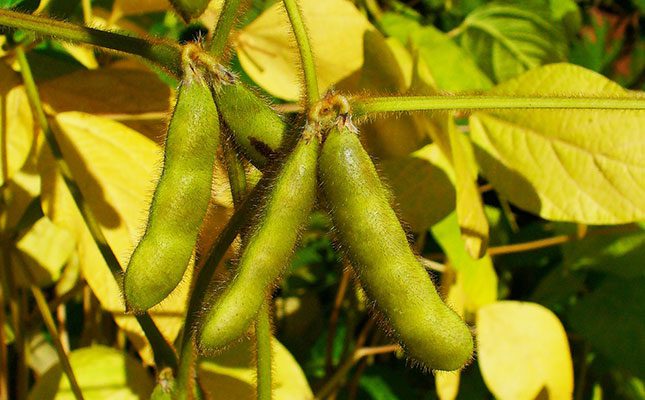
Why soya bean is a popular crop in SA
Soya bean production ranks among the most popular grain crops in South Africa and when it comes to planted area and yield, soya bean offers both economic opportunities and essential nutritional resources.
Over the years, the cultivation of soya bean has gained traction across various regions of the country, driven by its versatility, profitability, and the growing demand for plant-based protein sources.
Overview of soya bean and its importance in SA
Africa’s soya bean production is increasing fast – at a pace of about 7% annually – and is primarily due to an increase in the crop’s cultivated area rather than yield.
Over 35% of the continent’s soya bean production is accounted for by South Africa, the top producer in Africa.
Although all nine provinces in South Africa grow soya bean due to the commodity’s high socioeconomic importance and many commercially available cultivars that are climate-adapted, the majority of the crop is produced in the Free State, Mpumalanga and KwaZulu-Natal.
In 2023, the total area planted was 1 148 300ha, which delivered a harvest of 2 755 300t, the highest yield experienced over the past five seasons.
Although plantings have decreased to 1 036 600ha for the 2024 season (-9,7%), a harvest of about 2 170 000t is still expected and it remains well above the five-year average harvest, ensuring that South Africa remains a net exporter of soya bean (data from the Crop Estimate Committee).
In addition to their socioeconomic advantages, soya beans serve as a biological nitrogen source since the related Rhizobium and Bradyrhizobium microbes assist in fixing nitrogen in soils.
Nitrogen fertilisation is very costly and associated with environmental problems, including eutrophication of water and greenhouse gas emissions that worsen global warming.
One of the largest financial commitments that producers make to achieve target or projected yields in South Africa is the cost of adding synthetically produced nitrogen to crop fields as part of fertilisation programmes.
Therefore, when growing a legume crop like soya bean, biological nitrogen fixation is a valuable and environmentally safe alternative that deserves to be further utilised as an added value component.
The combination of improved soil properties and the ability to break life cycles of pests and diseases makes soya bean an ideal crop in cereal rotation programmes.
This advantage is especially important for crop production in Africa due to the economic limitations in the use of fertilisers.
Harvest challenges
Harvesting soya bean presents its own set of challenges and considerations, just like the planting stage.
Timing is critical, as harvesting too late can lead to significant losses due to shattering. Ideally, harvesting should occur when most of the leaves have fallen and the seeds contain a low moisture content but the stems are still flexible.
Experienced growers often assess ripeness by observing pod colour and breaking ability. Mature soya beans exhibit brown pods that break easily, although the kernels may not yet be completely dry.
Varieties vary in their splitting characteristics on maturity, with early or strong splitting posing challenges for mechanical harvesting.
Windrowing, stacking or manual harvesting are not suitable for soya bean, necessitating the use of a combine equipped with a wheat or soya bean table.
A self-propelled combine of adequate size is recommended to harvest around 14ha per day.
Optimal combining requires a slow drum speed, wider concave settings and a slow ground speed to minimise splits.
Lowering the combine close to the soil surface helps reduce pod losses. Timeliness in harvesting equipment availability is crucial, especially in anticipation of adverse weather conditions during the harvest season.
For instance, Fanie Yssel, technical manager of Limagrain Field Seeds South Africa, says wetter conditions experienced after a drought period cause regrowth of plants and prolonged flowering.
This contributes to uneven ripening of pods, resulting in more mature pods shattering on a plant, while others are not yet mature.
Certain soya bean cultivars may pose challenges during harvesting, particularly if they tend to carry pods close to the soil when stressed, requiring specialised machinery or risking crop losses.
Hence, prudent variety selection is essential, taking into account anticipated weather patterns for the upcoming season.
Challenges faced in production
As soya bean production in South Africa increases, the risk of exposure to various pests and diseases also increases.
Insect pests of soya bean occur sporadically and can become economically important, negatively affecting yield and quality when large numbers build up.
One of the most challenging insect pests that producers faced during the season was African bollworm (Helicoverpa armigera).
Bollworm
The pest status of African bollworm is exacerbated by its broad host range, feeding preference for reproductive parts of the plants, high fecundity, high mobility and ability to adapt to different climates by entering facultative diapause.
Bollworm larvae present a multifaceted threat to soya bean crops as they voraciously feed on various plant parts including leaves, buds, growing points, flowers and pods.
This feeding activity occurs across different growth stages of the plant, spanning from the vegetative phase to the flowering and ripened pod stages.
The consequential damage inflicted on leaves reduces the overall leaf area available for photosynthesis, thereby impeding the plant’s ability to synthesise essential nutrients.
If left unchecked, this can culminate in substantial losses in grain production.
Damage caused by this pest is recognisable by the clean, circular holes they bore through leaves and pods.
Bollworm larvae often deposit waste droppings away from the damaged plant components, making it difficult to detect them during scouting in fields.
Their propensity to burrow deeply into pods further complicates control efforts as they hide from exposure to insecticides once entrenched within the plant tissues.
Yssel says that in the previous harvest season, it was clear that bollworm infestation in crops had a significant economic impact on producers’ final profitability.
Where infestation is apparent, producers have to control it with insecticide spraying, he says. Depending on the level of infestation and the number of applications, production costs can escalate rapidly.
In his opinion, planting Limagrain’s Intacta Roundup Ready 2 Pro varieties is a successful preventative measure to control bollworm in soya bean.
This crop is also susceptible to various viral and fungal diseases caused by different organisms.
These diseases may result in low yield and poor quality of the grains and should be controlled from soil preparation until harvesting in order to obtain better yields.
Sclerotinia stem rot was one of the major fungal diseases that challenged producers last season.
Sclerotinia stem rot
Sclerotinia stem rot of soya bean is caused by the fungal pathogen Sclerotinia sclerotiorum. Infections occur anytime during flowering and symptoms can be observed on leaves, pods, seeds and stems.
Visual symptoms can be observed when the crop canopy between rows has closed, thus creating the ideal humid microclimate for infection and disease development.
A closer look within the crop canopy will reveal a cottony, white mycelial mass growing on stems, leaves and/or pods.
As the disease develops, white mycelia form and the lesions progress further until they circle the stem. Stems become wilted and take on a bleached appearance.
As the plant weakens, its stem becomes stringy, resulting in the lodging, wilting and death of the plant. Large, black sclerotia form from the white mycelium growing on plant tissues and in the stem pith.
Seeds in diseased pods are usually shrivelled and may be infected by the fungus or replaced by black sclerotia.
The seed is usually contaminated with sclerotia when infected plants are harvested.
Soya bean disease control measures
- Cultivar selection. The most important control strategy for Sclerotinia rot in soya bean is through proper variety selection. It is advisable to choose less susceptible varieties or varieties that have shown high yield under disease pressure when planting in soils with a history of the disease.
- Crop rotation. Every year, a portion of the pathogen population dies because of adverse weather conditions or the activities of other organisms. Rotation with a non-host crop such as maize, wheat or other grass will provide time for the fungal population to drop and reduce the risk of severe disease. Crop rotation with maize or wheat reduces levels of inoculum.
- Irrigation. Excessive irrigation during flowering should be avoided to minimise moisture at the soil surface and in the crop canopy. Low moisture levels within the soya bean canopy are critical for reducing the potential for Sclerotinia stem rot. Avoiding excessive irrigation is especially important during the critical periods of infection from early flowering to early pod development.
Deep ploughing can bury sclerotia so that they can no longer germinate and release spores. Under the wet conditions experienced in the previous season, Sclerotinia stem rot was a problem in many production areas.
Although complete resistance does not exist, Yssel explains that Limagrain has varieties that are less susceptible to Sclerotinia.
In consultation with your local salesperson, the right choice of cultivar can reduce the risk of huge losses due to Sclerotinia stem rot.
Why Soya bean?
The interest in soya bean products has grown recently in South Africa because of the health benefits associated with them. Soya bean consumption in the country is estimated at 67,8% for oil and oilcake, 15,29% for animal feed and 2,67% for human consumption.
Opportunities in soya bean production
Seeds of the soya bean plant are a versatile and vital resource, providing essential oil and protein for human consumption that is free from cholesterol and therefore used to help lower cholesterol and combat heart diseases.
Soya bean has the potential to fight malnutrition in Sub-Saharan Africa in the future due to its variety of uses.
Soya is consumed in various forms, including as a vegetable when unripe and as dried seeds, whole, split, or sprouted.
Soya beans can be processed for infant feeding and to produce curds and cheese, while fermented beans produce soy sauce and other sauces.
Roasted seeds serve as a coffee substitute, and highly nutritious sprouts are popular in Asia.
The seeds also yield oil, used in salad dressings, margarine and shortening, while processed soya beans are turned into flour for bakery and food products, additives and extenders.
Industrially, soya bean oil finds application in paints, inks and soaps, while lecithin phospholipids have various industrial uses.
In animal feed, soya bean oil cake is a crucial protein component, especially in the poultry industry, which has a high demand for quality protein.
Soya meal is increasingly sought after as a rich protein feed for livestock. Additionally, the plant’s vegetative parts can be utilised for silage, hay or green manure.
Conclusion
The economic benefits of soya bean production in South Africa are enormous.
The obstacles caused by diseases and insect pests emphasise the importance of sustainable and integrated pest management techniques to maximise production potential, strengthen agricultural resilience, improve producer livelihoods and guarantee food security and economic development.
Email Fanie Yssel, technical manager at Limagrain South Africa, at fanie.yssel@limagrain.com.
Source: Farmersweekly.co.za
